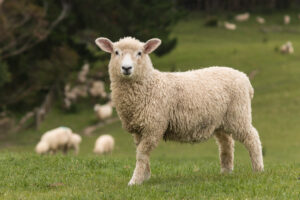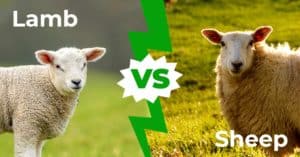Have you ever looked into the eyes of a sheep or goat? You may notice that they are very unusual from other animals.
Sheep and goat eyes are also very similar in appearance, almost indistinguishable. But, there are some differences.
Let’s analyze the two: sheep eyes vs. goat eyes. Learn about the appearance, vision capabilities, and functionality of sheep and goat eyes.
Comparing Sheep Eyes Vs. Goat Eyes
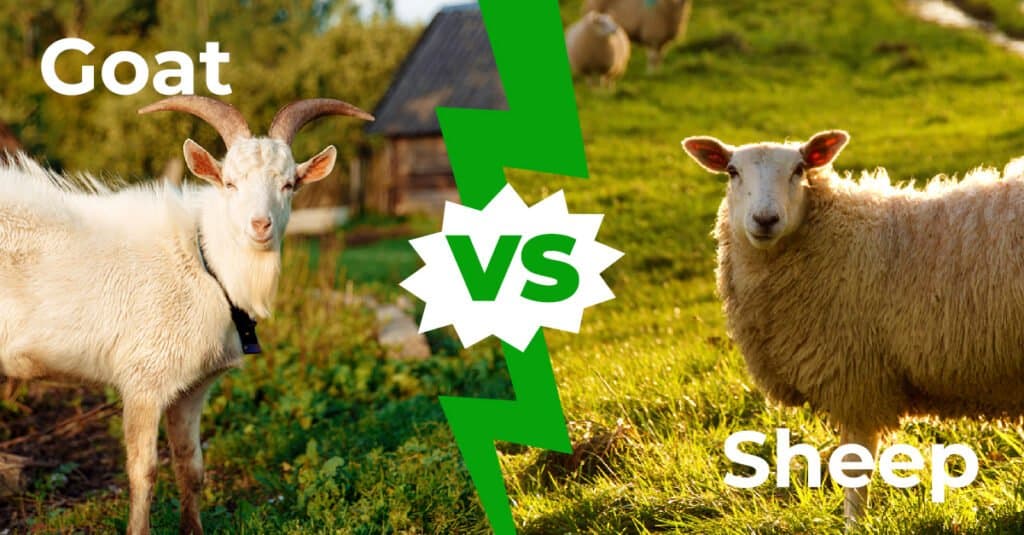
| Characteristics | Sheep Eyes | Goat Eyes |
|---|---|---|
| Pupil Shape | Rectangular | Rectangular |
| Color | Brown or greenish-tan | Light brown or blue |
| Field of Vision | 270 to 320 degrees | 320 to 340 degrees |
| Vision Function | Poor depth perception, blind spot in front of its nose | Adequate depth perception and no front blind spot |
Key Differences Between Sheep Eyes Vs. Goat Eyes
Sheep and goat eyes are very similar in appearance. You may not see a difference by just looking at them. However, there are distinct differences, especially in functionality.
The easiest difference to spot is color. Sheep eye color ranges from brown to greenish-tan, and goat eyes are typically blue or light brown.
Most differences are hidden from the naked eye and are only known due to scientific studies. Goats have a better field of vision than sheep and better depth perception.
Let’s cover the differences in shape, color, vision, and purpose.
Sheep Eyes Vs. Goat Eyes: Shape

Goats and sheep have rectangular pupils that serve a purpose.
©Daria-Borovleva/Shutterstock.com
Both goats and sheep have rectangular pupils that look like horizontal slits. People have described their eyes as unusual and unsettling to look at. And while they may differ significantly from human eyes, their appearance serves a purpose.
If you look closely as a sheep or goat rotates its head, you will notice that its eyes stay perfectly parallel to the ground. Why is this?
The eyes are on the sides of the head, combined with elongated pupils. This remarkable combination allows for a wide field of view. These animals can essentially see all around.
This odd pupil shape allows for enhanced lighting and image quality of the animal’s surroundings.
In fact, goats and sheep are not the only animals with rectangular-shaped pupils. All grazing animals have slitted pupils. You will see the same shape in horses and deer.
A comparative study performed on sheep and goat eyes found that the size and shape of the optic disc were different. The optic disc represents the beginning of the optic nerve, which also acts as a blind spot.
Goats have a narrow blind spot behind their head, while sheep have a blind spot immediately in front of their nose and the back of their head when raised.
Sheep Eyes Vs. Goat Eyes: Color
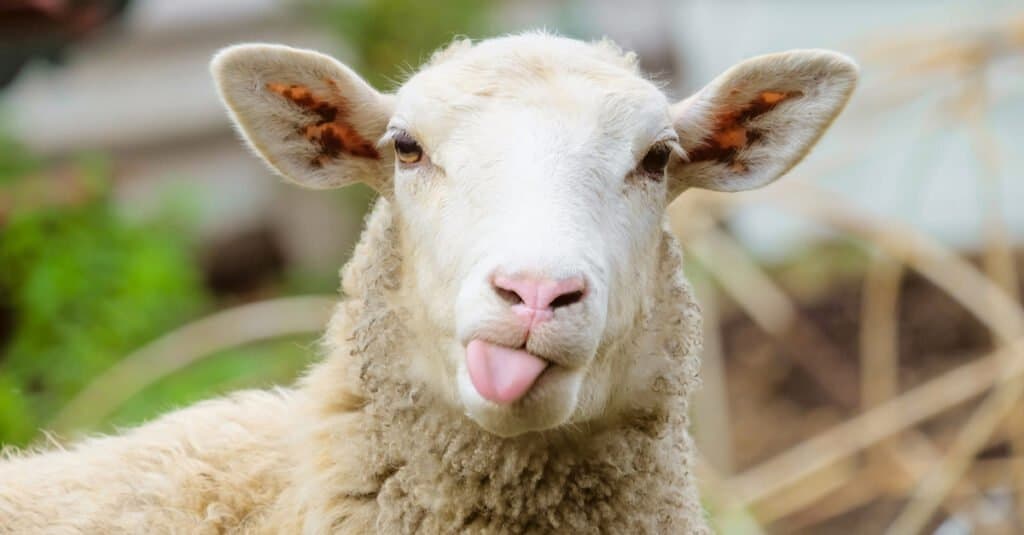
Goats have blue and brown eyes, while sheep eyes are shades of brown.
©N-sky/Shutterstock.com
Goat eye color ranges between light blue, light brown, or amber. Blue eye color is a dominant trait most commonly seen in Nigerian Dwarfs. It is common for goats to have almost all white irises with a speck of blue.
In more rare occurrences, you may see goats with marbled color eyes (brown and blue mixed together) and two different colored eyes (one brown and one blue).
Sheep eyes usually are various shades of brown. They can range from light brown to a darker amber color. Some sheep’s eyes take on a more green color mixed with brown. Lamb’s eyes are often a golden yellow to light brown color.
In rare instances, sheep can have blue eyes. This phenomenon occurs in rams every so often.
Sheep Eyes Vs. Goat Eyes: Vision
Sheep and goats have excellent vision.
Goats have almost a complete 360-degree view of their surroundings (between 320 and 340 degrees). Sheep also have perfect peripheral vision with a view between 270 and 320 degrees.
Both sheep and goats have adequate night vision and are happy to graze in the dark unattended. However, they still see better in the daytime. The shape of their pupils controls the amount of light in the eye. More light is let in at night, and less light is let in during the brightest part of the day.
Contrary to what many believe, goats and sheep can see color. But because they only have two color receptors, they cannot see the full-color spectrum. These animals seem to notice yellow, orange, green, violet, blue, and red colors.
Due to their excellent peripheral vision, they lack depth perception. Goats have slightly better depth perception (up to 63 degrees), especially peripheral depth perception. Sheep have a depth perception between 20 and 60 degrees.
Due to their wide-angle vision, these grazing animals are extremely sensitive to motion. The slightest movement around them may have them startled.
Sheep Eyes Vs. Goat Eyes: Purpose
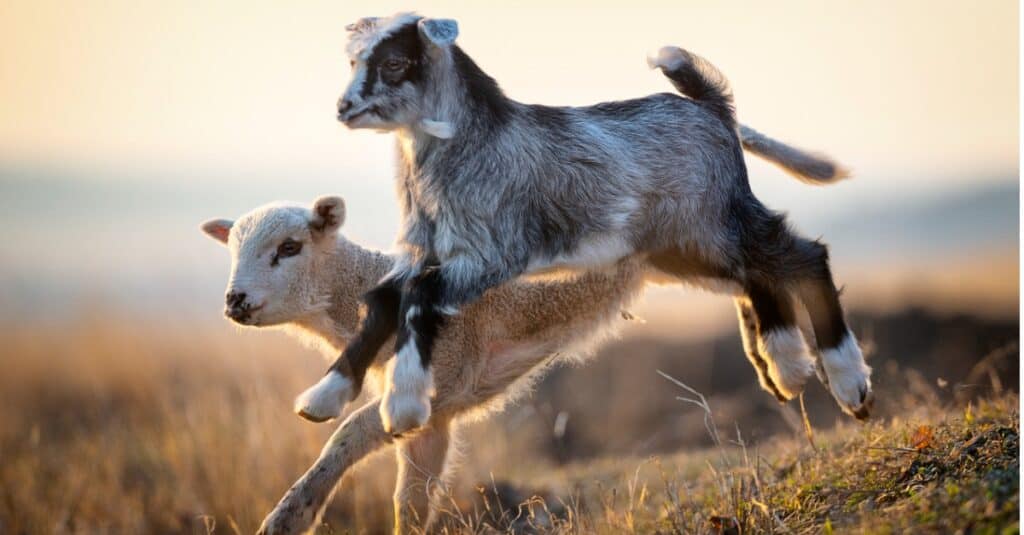
Rectangular pupils indicate that sheep and goats are prey animals.
©iStock.com/Tutye
Pupil shape determines whether an animal is a predator or prey.
The rectangular pupil of sheep and goats indicate that these species are prey animals. The horizontal slits give prey a wide-angle view of the world around them, and they can detect even the faintest movement.
Grazing prey animals have evolved for the greatest chance of survival against predators. Even for sneaky animals who quietly stalk behind them, they have up to a 340-degree view and can easily detect motion. These features allow them to escape their predators and run to safety.
As a goat or sheep bends its head to eat, its eyes stay parallel to the ground, always watching for predator animals. Its pupils also control the amount of light let in, so they can clearly see in the dark and during the bright afternoon.
The only limitations to these animals’ vision are their poor depth perception and blind spots.
The photo featured at the top of this post is ©
Thank you for reading! Have some feedback for us? Contact the AZ Animals editorial team.



